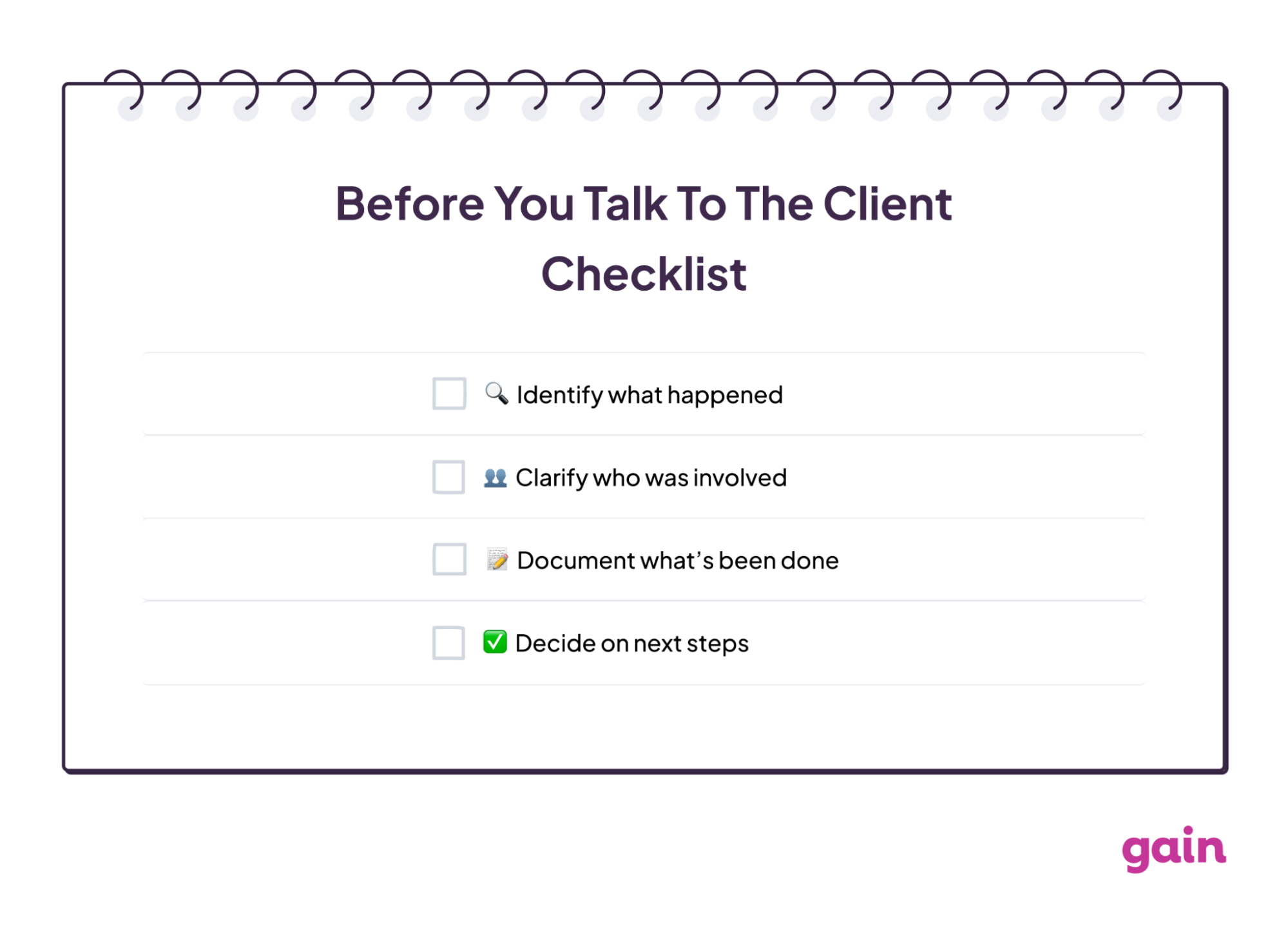Mistakes are part of doing business, especially in fast-paced client work where deadlines, approvals, and deliverables all collide. While no agency or freelancer can avoid them entirely, what truly matters is how you respond.
Handled poorly, a small slip can spiral into lost trust, bad reviews, or even a broken contract. But when you own up to an error and communicate it well, you can actually strengthen your client relationship. In some cases, clients walk away more confident in your professionalism than before the mistake happened.
So how do you strike the right balance between transparency and reassurance? Below, we’ll walk through practical steps, email examples, and prevention strategies to help you address mistakes with honesty – and turn them into opportunities to build lasting trust.
Before the Conversation
Before you reach out to a client, it’s important to pause and prepare. Having the right information and choosing the right communication channel will set the tone for how the mistake is received. Here’s what to do first:
Prepare for Telling the Client What’s Happened
When a mistake happens, resist the urge to immediately message your client. Instead, pause and gather all the facts. You want to walk into the conversation fully prepared, not scrambling for answers.

Start by investigating internally:
- Identify what happened. Was it a reporting error, a scheduling mistake, a missed deadline, or something else?
- Clarify who was involved. Was the issue caused by a miscommunication within your team, a process breakdown, or a technical problem?
- Document what has already been done. Has the error been corrected? What temporary fixes are in place?
- Decide on next steps. What concrete actions will prevent this from happening again?
You should always conduct an internal review first to avoid speculation and give your client a clear, confident update.
Pick an Appropriate Medium
Whenever you need to have a difficult conversation, the best option is to organize a call or in-person meeting. With your tone, you can communicate the situation calmly, helping to avoid miscommunications and defuse the situation. It also shows a willingness to take responsibility and hear from them personally, which is harder than just sending a message.
If the error is a small one, then sending an email update may be enough, depending on the timing. However, sending an informal message, such as a text or Slack, is often too casual for this type of communication.
During the Conversation
Once you sit down with your client, whether that is in a meeting room, on a call, or over Zoom, the pressure is real. This is the moment where trust can be rebuilt or lost. How you carry yourself matters just as much as the words you choose. Speak calmly, stay professional, and be direct about what happened.
Keep it Concise
Although you have all the details, there is no need to give your client a long version of the situation if it’s unnecessary. Doing so can overcomplicate things and make them feel more worried than they need to be.
Instead, provide them with a summary of the problem and the solution. With this approach, you maintain perspective and avoid escalating the issue. Just be sure to make it clear that there is an error that needs fixing, and don’t overly downplay or avoid the issue entirely.
Take Responsibility
Taking responsibility is one of the most important things to do when you’ve made a mistake. If you pass the blame, your client will lose trust in you, and it may permanently damage your relationship.
By apologizing and recognizing your role in causing the mistake, you demonstrate your honesty and trustworthiness, as well as your ability to analyze the situation fairly. You also establish a foundation of trust so that your clients believe you will handle any situation – difficult or not – with fairness and honesty.
Don’t Get Defensive
Your client may have a strong reaction, depending on the seriousness of the mistake. Take their unhappiness and criticism on board and use it productively. Although they may be upset, try not to react. Instead, stay calm and professional.
After the Conversation
What you do after the meeting matters just as much as what you said during it. This is the stage where you rebuild confidence. Act quickly to fix the issue, keep your client updated, and show that you are taking their concerns seriously.
Focus on Solutions
Though you need to let your client know what happened, reassure them that you are already taking action to fix it. Start by telling them what has been done as an immediate response. Depending on your client, it may be better to show that you have thought through the whole process to resolve the mistake, or you may want to involve them.
If you want them to feel involved, give your client some options for different next steps to fix the solution, so they feel they have some control over the situation, too. Alternatively, you could include them in the discussion about how to avoid the mistake in the future so that they have some say in the way things happen moving forward.
Continue Communicating
Communicate regularly as you address the mistake so that clients know you are making progress. Be available to answer their questions, and make sure you are patient with them.
Their trust in you and your team might be shaken, so by keeping them up to date, you will help rebuild that trust.
Learn from Your Mistakes
Once you rectify the error, make sure that you don’t make the same mistake again. Take the time to discuss with your team what led to the mistake in the first place, and what changes you need to make to prevent it in the future. It could mean adjusting your approval processes, reorganizing some responsibilities, or upgrading some of your tools.
How to Tell A Client You Made a Mistake Email Examples
If the mistake isn’t huge and doesn’t require a call with the client, you can simply send an email. Here are a couple of templates to help you craft it 👇
Example 1: Formal Email
Dear [Client's Name], I hope you are doing well. I'm writing to address a situation regarding the marketing report we provided to you recently. Regrettably, there was an error in the data analysis, and I take full responsibility for this oversight. [Explain the mistake briefly, e.g., "In our recent report, we inadvertently included inaccurate data points, which may have led to some confusion."] Please rest assured that we are taking immediate steps to rectify this issue: • Corrected Report: We have already prepared a corrected version of the report with accurate data and insights, which will be sent to you shortly. • Quality Control: We are reviewing and enhancing our quality control processes to prevent such errors in future reports. • Client Updates: To improve transparency, we will provide more frequent updates on our reporting process and seek your input to ensure we meet your expectations. I sincerely apologize for any inconvenience this may have caused you. We deeply value your partnership, and your trust means everything to us. We remain committed to delivering the highest level of service and accuracy. If you have any questions or require further clarification about this matter or anything else related to our work, please feel free to reach out. Your feedback is invaluable to us, and we are here to assist you. Thank you for your understanding. Warm regards, [Your Name] [Your Contact Information]
Example 2: More casual email
Hi [Client’s Name],
I wanted to send you a quick update regarding the [project/report/campaign] we shared with you. I noticed a small error in [specific area, e.g. “the ad spend numbers for July”] and have corrected it. The updated version is attached here.
Apologies for the oversight, and thank you for your understanding. Please rest assured that we’ve double-checked everything else to make sure it’s accurate moving forward.
As always, if you have any questions, just let me know.
Best,
[Your Name]
3 Ways to Prevent Mistakes when Working with Multiple Clients
When you’re managing several clients at once, mistakes can slip through the cracks. Missed deadlines, approval mix-ups, or forgotten details are common when you’re juggling campaigns across multiple channels. The good news is you can reduce those errors with the right systems and tools in place.
1. Streamline Client Onboarding
A strong start reduces confusion later. Create a clear onboarding process that includes intake forms, client questionnaires, and kickoff meetings. Gather essential information about goals, preferences, and expectations upfront. The more clarity you have from day one, the less chance there is for miscommunication down the line.
2. Automate Approvals and Tasks
Errors often happen when processes rely on too many emails or manual steps. If you’re still chasing approvals in long email threads, mistakes are almost guaranteed. Tools like Gain can help by automating content approvals and consolidating client feedback in one place. With deadlines, reminders, and version tracking built in, your team stays organized at all times.
📖 Related Read: 17 Must-Have Agency Tools to Run & Scale Operations
3. Strengthen Internal QA
Finally, protect yourself with a solid quality assurance process. Hold regular check-ins, run peer reviews, and create checkpoints at key project milestones. Encourage your team to flag issues early so they’re fixed before they ever reach the client. Strong internal communication and accountability make it much harder for mistakes to repeat.
FAQs
Start by being upfront and clear. Clients can usually tell when something is being brushed over, so honesty goes a long way. A good way to approach it is first to acknowledge the mistake, then explain in simple terms what went wrong and how it happened. Don’t get bogged down in unnecessary details or technical jargon unless your client really wants that level of context. The key is to show that you understand the problem, you’ve taken it seriously, and you already have a plan to fix it. Wrapping up with what you are doing to prevent the same issue in the future will reassure them you are in control.
Keep it genuine and professional. Clients don’t need a dramatic apology, but they do want to see accountability. A straightforward approach works best: acknowledge the mistake, say you are sorry, and explain how you are fixing it. Also, avoid shifting the blame to someone else or making excuses. For example, you might say, “I want to apologize for the reporting error in last week’s update. It was our oversight, and I’ve already corrected the numbers and updated the process to make sure it doesn’t happen again.” Pairing your apology with an action plan shows that you care about their business and their trust.
You should reach out once you understand both what went wrong and how you are addressing it. Clients don’t want to be kept in the dark, but they also don’t want to hear “something went wrong” with no explanation or solution. A good rule is to act quickly but come prepared. If the error is minor and you can fix it within a few hours, you may be able to send the corrected version with a brief explanation at the same time. If it is bigger, let them know promptly, but come ready to outline what steps you are taking to resolve it.
The Bottom Line
Owning up to your mistakes can be difficult and takes some practice. That said, communicating the situation to a client is crucial for maintaining a strong relationship based on trust. The good news is that most clients will be understanding of the occasional mistake; after all, everyone messes up from time to time.
Put these tips into use and be proactive, clear, and communicative with your clients, and you’ll get through it while also learning a valuable lesson for your business.
If content approval has been a stumbling block for your agency, you need a solution like Gain. Gain is an easy-to-use tool that automates the gathering of feedback and approvals from clients or stakeholders, specifically designed for marketing assets. With Gain, nothing gets published without client approval, helping you prevent mistakes before they happen and giving your clients extra peace of mind.
Start a free trial and save precious time with an automated approval workflow for all your marketing content!






